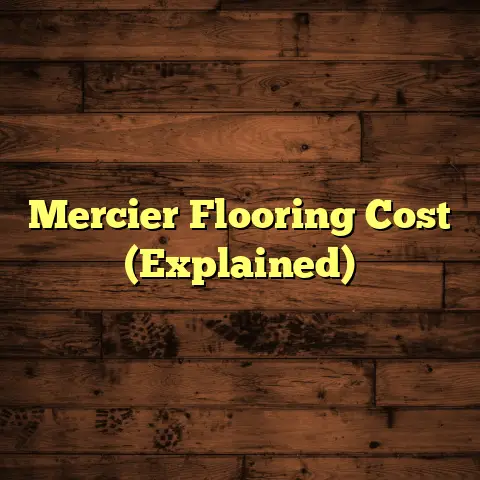Hard Mat On Carpet? (1 Mistake Ruins Floors!)
I’ve seen it all when it comes to flooring, the good, the bad, and the downright ugly.
And believe me, nothing makes my heart sink quite like seeing a beautiful carpet ruined by something totally preventable – a hard mat!
Imagine this: you walk into your living room, ready to sink your toes into that plush, inviting carpet you love.
But instead, you’re greeted by a stiff, unyielding hard mat stubbornly sitting on top.
Not the cozy welcome you were hoping for, right?
This isn’t just about aesthetics, my friends. Placing a hard mat directly on your carpet can actually lead to some serious damage.
I’m talking crushed fibers, mold growth, and even permanent indentations. Yikes!
In this article, I’m going to break down exactly why this happens, how to avoid it, and what to do if you’ve already made this mistake.
Trust me, a little knowledge can save you a lot of headaches (and money!) down the road.
So, grab a cup of coffee, settle in, and let’s get your floors looking their best!
1. Understanding Carpet and Hard Mats
First things first, let’s get acquainted with our key players: the carpet and the hard mat.
Think of it like understanding the tools in your toolbox – knowing what they are and what they’re meant for is half the battle.
1.1 The Anatomy of a Carpet
Carpets are more than just soft surfaces. They’re complex structures made of various materials, each with its own properties.
-
Materials Matter:
-
Synthetic Fibers: Nylon, polyester, and olefin are common synthetic choices. They’re durable, stain-resistant, and budget-friendly. Nylon is known for its resilience, while polyester offers excellent color retention.
-
Natural Textiles: Wool, cotton, and sisal bring a touch of luxury and eco-friendliness. Wool is incredibly soft and naturally stain-resistant, but it can be pricier.
-
-
Construction Counts:
-
Pile Height: This refers to the length of the carpet fibers. Higher pile carpets feel plusher but can be more prone to crushing.
-
Density: Density is how closely packed the fibers are. A denser carpet will generally be more durable and resistant to wear and tear.
-
Did you know that the average carpet has around 25,000 individual fibers per square inch? That’s a lot of potential for damage if you’re not careful!
1.2 Types of Hard Mats
Now, let’s talk about hard mats. These come in all shapes, sizes, and materials, each designed for a specific purpose.
-
Rubber Mats: These are often used as doormats or in gyms. They’re durable and provide good traction, but they can be quite rigid.
-
Plastic Mats: Plastic mats are lightweight and easy to clean, making them popular for office spaces or under desks.
-
Wooden Mats: These add a touch of elegance but can be unforgiving on softer surfaces.
The problem? Hard mats are designed to withstand heavy traffic and provide a firm surface.
When you place them on carpet, you’re essentially putting a rigid object on top of a flexible one, creating a recipe for disaster.
2. The Impact of Hard Mats on Carpet
Okay, so now you know what carpets and hard mats are made of. But what happens when you put them together?
Unfortunately, it’s not a match made in heaven.
2.1 Physical Damage
This is where things get ugly. Hard mats can wreak havoc on your carpet fibers.
-
Crushing and Flattening: The weight and rigidity of the mat compress the carpet fibers, causing them to flatten over time. This is especially noticeable in high-pile carpets.
-
Indentations and Marks: Ever noticed those annoying indentations left by furniture? Hard mats can do the same thing, leaving permanent marks that are difficult to remove.
I’ve seen carpets where the area under a hard mat looks completely different from the surrounding area. It’s like a before-and-after photo, but not in a good way!
2.2 Moisture Issues
This is a sneaky one that many people don’t think about.
-
Trapped Moisture: Hard mats can prevent air circulation, trapping moisture underneath. This creates a breeding ground for mold and mildew.
-
Indoor Air Quality: Mold and mildew can release harmful spores into the air, affecting your indoor air quality and potentially causing health problems, especially for those with allergies or asthma.
According to the EPA, indoor air can be more polluted than outdoor air. Trapped moisture under a hard mat can definitely contribute to this problem.
2.3 Aesthetic Disruption
Let’s not forget about the visual impact.
-
Visual Harmony: A hard mat can clash with the softness and texture of your carpet, creating a jarring visual contrast.
-
Psychological Effects: Visual clutter can actually increase stress levels. A mismatched hard mat can contribute to this feeling of unease.
Think about it: you carefully chose your carpet to create a specific mood in your room. Why ruin it with an unsightly hard mat?
3. The One Mistake That Ruins Floors
Alright, let’s cut to the chase. What’s the big mistake we’re talking about?
3.1 The Misplacement of Hard Mats
The primary mistake is simple: placing hard mats directly on carpet without considering their impact.
It sounds obvious, but you’d be surprised how many people do it without thinking twice.
I remember one client who placed a heavy rubber mat under her desk chair to protect her carpet from rolling.
A year later, the carpet underneath was completely flattened and discolored. She had to replace the entire section!
3.2 The Chain Reaction of Damage
This mistake sets off a chain reaction of damage.
-
Immediate Physical Damage: The hard mat starts to crush the carpet fibers.
-
Moisture Trapping: Air circulation is restricted, leading to moisture buildup.
-
Mold and Mildew Growth: The trapped moisture creates a breeding ground for harmful organisms.
-
Permanent Damage: Over time, the carpet fibers become permanently flattened and discolored.
-
Costly Repairs or Replacements: If left unchecked, this can lead to expensive repairs or even the need to replace the entire carpet.
It’s like a domino effect, one small mistake leading to a cascade of problems.
4. Preventative Measures and Best Practices
Okay, enough doom and gloom! Let’s talk about how to avoid this disaster altogether.
4.1 Choosing the Right Mat
The first step is to choose the right mat for the job.
-
Carpet-Friendly Mats: Look for mats specifically designed for use on carpet. These often have a softer, more flexible backing that won’t damage the fibers.
-
Mat Features: Consider mats with breathable materials or raised patterns that allow for air circulation.
I always recommend using mats with a felt or rubber backing that’s specifically designed for carpet. These provide a cushion and prevent the hard surface from directly contacting the carpet fibers.
4.2 Proper Placement Techniques
Even with the right mat, placement matters.
-
Avoid High-Traffic Areas: If possible, avoid placing hard mats in areas with heavy foot traffic.
-
Use a Barrier: Place a thin piece of carpet padding or felt between the hard mat and the carpet to provide an extra layer of protection.
I’ve seen people use old towels or blankets as a barrier, but I wouldn’t recommend it. These can trap moisture and create even more problems.
4.3 Maintenance and Care
Regular maintenance can go a long way in protecting your carpet.
-
Rotate Mats: Rotate your mats regularly to prevent concentrated wear and tear in one area.
-
Clean Carpets: Regularly vacuum and clean your carpets to remove dirt and debris that can contribute to damage.
-
Address Moisture: If you notice any moisture under your mat, remove it immediately and allow the carpet to dry thoroughly.
I recommend vacuuming your carpets at least once a week and having them professionally cleaned every 6-12 months.
Conclusion: The Value of Awareness
So, there you have it! Placing a hard mat on carpet might seem like a harmless act, but it can have serious consequences.
By understanding the potential damage and taking preventative measures, you can protect your carpets and keep your home looking its best.
Remember, awareness is key. By being mindful of your flooring choices, you can avoid costly repairs and enjoy the comfort and beauty of your carpets for years to come.
And if you ever have any questions or need help with your flooring, don’t hesitate to reach out to a professional like myself.
We’re here to help you make the best choices for your home!





